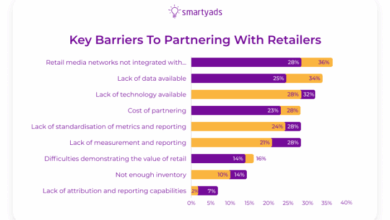
B2b e commerce the quiet giant – B2B e-commerce the quiet giant is a massive force, often overlooked in favor of the flashy B2C sector. This quiet giant is transforming business-to-business transactions, streamlining processes, and unlocking new opportunities for growth. From understanding the nuances of B2B versus B2C to exploring the technologies driving this evolution, this exploration delves into the heart of this powerful market.
This deep dive examines the key characteristics of B2B e-commerce, highlighting its differences from B2C. We’ll also analyze market trends, explore challenges and opportunities, and examine the crucial role of technology and customer experience in shaping the future of B2B commerce. Prepare to uncover the quiet giant’s secrets!
Introduction to B2B E-commerce

B2B e-commerce, or business-to-business electronic commerce, is the digital exchange of goods and services between businesses. It encompasses a wide array of online transactions, from procuring raw materials to selling finished products to other businesses. This digital marketplace has revolutionized how companies conduct their trade, offering significant advantages in efficiency and cost-effectiveness.Unlike consumer-to-business (B2C) e-commerce, which focuses on selling products directly to end-users, B2B e-commerce targets businesses as customers.
This distinction necessitates tailored features and functionalities to address the specific needs and complexities of business-to-business transactions. The “quiet giant” in the context of B2B e-commerce refers to its often understated but profoundly impactful role in driving global trade. While B2C e-commerce receives a lot of attention, B2B e-commerce is the engine that keeps many businesses running smoothly.
Key Characteristics of B2B E-commerce
B2B e-commerce differs significantly from B2C in several key aspects. Crucial distinctions include the volume of transactions, the negotiation process, and the relationship-based nature of the interactions. B2B transactions are typically larger in value and involve more complex logistical considerations than B2C purchases. Negotiations are common, and often involve factors like discounts, payment terms, and customized product specifications.
Building and maintaining strong business relationships are critical to successful B2B e-commerce, and the transactions often involve repeat customers and established partnerships.
Types of B2B E-commerce Platforms
Understanding the diverse range of B2B e-commerce platforms is essential to grasping their multifaceted role in facilitating business transactions. These platforms cater to specific needs, from simple ordering systems to complex enterprise solutions.
| Platform Type | Key Features | Target Audience | Typical Use Cases |
|---|---|---|---|
| Direct-to-Business (D2B) Platforms | Focus on direct sales from manufacturers to distributors or retailers. Often feature detailed product information, bulk discounts, and efficient order management. | Distributors, wholesalers, retailers, and other businesses seeking to purchase in bulk. | Purchasing raw materials, components, or finished goods; Reselling products to other businesses; Managing inventory efficiently. |
| Online Marketplaces | Act as intermediaries connecting businesses seeking to buy and sell. Offer a wide selection of products and services from various suppliers. | Businesses of all sizes looking to find suppliers, partners, or customers. | Finding and sourcing specific products or services; Expanding their network of business partners; Locating suppliers for a specific need. |
| Enterprise Resource Planning (ERP) Systems | Integrate various business processes into a single system. Often include B2B e-commerce functionalities for managing orders, inventory, and payments. | Large corporations and enterprises with complex supply chains and extensive operations. | Streamlining internal processes; Managing complex orders and logistics; Integrating B2B e-commerce with existing systems. |
| Industry-Specific Portals | Tailored to particular industries, providing a specialized platform for buyers and sellers. | Businesses within a specific industry looking for specialized products or services. | Finding industry-specific suppliers; Establishing connections within a niche market; Accessing industry-relevant information and resources. |
Market Trends and Growth: B2b E Commerce The Quiet Giant
B2B e-commerce is experiencing explosive growth, driven by evolving business needs and technological advancements. Businesses are increasingly recognizing the efficiency and cost-effectiveness of digital platforms for procurement, sales, and collaboration. This shift is reshaping supply chains and fostering new opportunities for companies of all sizes. The market’s future looks bright, promising significant growth and transformation.The rapid expansion of B2B e-commerce is fueled by several key factors, including the rising demand for streamlined processes, the need for greater transparency and control, and the desire for enhanced customer experiences.
Businesses across various industries are seeking ways to optimize their operations and enhance their relationships with suppliers and clients. This is where the digital realm shines, offering a solution to traditional inefficiencies.
B2B e-commerce is often overlooked, but it’s a powerful force quietly shaping the business world. Recent news about Cybershop signing a marketing deal with go2net, as detailed in this article cybershop signs marketing deal with go2net , highlights the growing importance of these platforms. This kind of strategic partnership further underscores the increasing dynamism within the B2B e-commerce landscape, and points to its continued, substantial growth.
Current Market Size and Growth Projections
The global B2B e-commerce market is substantial and continuously expanding. While precise figures vary depending on the source and methodology, reports consistently indicate a robust growth trajectory. Many estimates project continued double-digit annual growth rates in the coming years, driven by the factors mentioned above. For example, a recent report from [insert reputable research firm] forecasts the market to reach [insert specific figure] by [insert year], demonstrating the significant potential for further expansion.
Key Factors Driving B2B E-commerce Growth
Several crucial factors are propelling the growth of B2B e-commerce. These include:
- Increased demand for efficiency and automation: Businesses are increasingly seeking ways to streamline their operations, reduce manual processes, and enhance productivity. B2B e-commerce platforms offer a powerful tool for achieving these goals, automating tasks, and optimizing supply chains.
- Improved transparency and traceability: B2B e-commerce fosters greater transparency and traceability in supply chains. Businesses can track orders, inventory, and shipments with ease, improving visibility and accountability throughout the process. This trust-building aspect is crucial in establishing reliable supplier-customer relationships.
- Enhanced customer experience: B2B e-commerce enables businesses to provide a superior customer experience by offering personalized services, faster delivery options, and secure payment gateways. A seamless online experience is a key differentiator in a competitive market.
Comparison of B2B and B2C E-commerce Growth
While both B2B and B2C e-commerce are experiencing substantial growth, the dynamics differ significantly. B2B transactions typically involve larger order values and more complex processes than B2C orders. Furthermore, B2B e-commerce often relies on customized solutions and tailored services to meet the specific needs of businesses. The decision-making process in B2B is more intricate, involving multiple stakeholders, which necessitates specialized platforms and tailored interactions.
This complexity, while potentially more challenging, also often leads to larger revenue generation for the platform compared to the B2C model.
Key Market Trends in B2B E-commerce
The B2B e-commerce landscape is constantly evolving, influenced by several key trends. These trends present both challenges and opportunities for businesses seeking to capitalize on this dynamic market.
B2B e-commerce is often overlooked, a quiet giant in the digital world. It’s a powerful force, quietly revolutionizing how businesses buy and sell. Think of the “as seen on tv” phenomenon, as seen on tv , where products gain traction through aggressive marketing. Similarly, B2B e-commerce, despite its less flashy presentation, is steadily changing the landscape of global trade, connecting businesses in ways never before possible.
| Trend | Explanation | Impact on Businesses | Potential Opportunities |
|---|---|---|---|
| Mobile Commerce | Growing use of mobile devices for B2B transactions. | Increased accessibility and flexibility for businesses, enabling transactions anytime, anywhere. | Development of mobile-optimized platforms and tailored mobile experiences to enhance user engagement and streamline operations. |
| AI-powered Automation | Integration of artificial intelligence to automate tasks and improve efficiency. | Reduced manual efforts, improved accuracy, and faster processing of orders. | Creation of intelligent systems for personalized recommendations, automated order fulfillment, and predictive analytics to anticipate future needs. |
| Blockchain Technology | Use of blockchain for secure and transparent transactions. | Enhanced security and trust in supply chain management and business-to-business exchanges. | Development of secure platforms that provide end-to-end transparency and traceability. |
| Sustainable Practices | Focus on environmentally conscious and socially responsible sourcing and operations. | Growing demand for ethical and sustainable business practices. | Opportunities to differentiate through sustainable offerings, certifications, and responsible supply chain management. |
Challenges and Opportunities
Navigating the complexities of B2B e-commerce requires a strategic approach. Businesses must understand the unique hurdles and advantages inherent in this digital marketplace to thrive. The digital transformation of business-to-business interactions has ushered in a new era of opportunities, but also presents specific challenges that must be addressed proactively.The key to success in B2B e-commerce lies in understanding these challenges and leveraging the opportunities they present.
This involves careful consideration of various e-commerce models, their inherent strengths and weaknesses, and the specific needs of different industries.
Key Challenges Faced by Businesses
Businesses adopting B2B e-commerce often encounter challenges related to integration, security, and customer experience. Existing legacy systems, differing data formats, and the need for seamless integration with internal processes can prove complex. Security concerns surrounding sensitive financial transactions and the protection of confidential business information are paramount. Building a robust and engaging online experience for B2B customers, fostering trust, and enabling personalized interactions, can also be demanding.
Opportunities for Businesses Leveraging B2B E-commerce
B2B e-commerce presents a wealth of opportunities for businesses to streamline operations, expand market reach, and enhance customer relationships. Increased efficiency through automated order processing, inventory management, and communication channels can dramatically reduce costs and improve profitability. Global reach allows businesses to tap into new markets and expand their customer base beyond geographical limitations. Personalized experiences based on customer data and purchase history can foster stronger customer relationships and drive repeat business.
Innovation in B2B E-commerce
Innovation in B2B e-commerce is driven by the constant need to enhance efficiency, personalize interactions, and provide value-added services. Artificial intelligence (AI) and machine learning (ML) are being integrated to automate tasks, predict customer needs, and offer tailored recommendations. Blockchain technology is being explored for secure transactions and enhanced supply chain transparency. Augmented reality (AR) and virtual reality (VR) are emerging as tools to provide immersive product demonstrations and training experiences.
Comparison of B2B E-commerce Models
Different B2B e-commerce models cater to various needs and industry requirements. A comprehensive understanding of the strengths and weaknesses of each model is essential for informed decision-making.
| Model | Advantages | Disadvantages | Use Cases |
|---|---|---|---|
| Direct-to-Consumer (DTC) | Direct customer relationships, potentially lower costs, access to customer feedback. | Requires significant marketing investment, potential for customer service overload, may not be suitable for complex product offerings. | Selling highly customized products, building brand awareness, establishing a direct relationship with customers. |
| Marketplace Model | Broader reach, increased visibility, reduced marketing costs, access to a large pool of potential customers. | Competition from other sellers, potential for lower margins, need for strict moderation policies to maintain quality standards. | Selling products or services in a competitive market, creating a platform for various vendors, and offering a wider range of products or services. |
| Dedicated B2B Portal | Secure transactions, tailored customer experience, dedicated support for business needs. | Higher development costs, potential for limited reach, requires careful maintenance and support. | Selling complex, high-value products or services, managing relationships with key accounts, offering customized solutions. |
| Wholesale/Distributor Model | Scalability, efficient distribution networks, established channels for reaching businesses. | Dependence on distributors, limited control over customer relationships, potential for conflict of interest. | Selling products in bulk to distributors or wholesalers for further distribution, managing large volumes of orders, establishing strong partnerships. |
Technology and Infrastructure
B2B e-commerce thrives on robust technology and infrastructure. Modern platforms leverage digital tools to streamline complex business processes, automate tasks, and enhance customer experiences. This technological backbone enables businesses to efficiently manage orders, track inventory, and communicate with partners, leading to improved operational efficiency and cost savings.The technological landscape of B2B e-commerce is constantly evolving, with new innovations and advancements continually shaping the way businesses operate.
This dynamic environment necessitates a deep understanding of the crucial technological components and infrastructure that support these platforms, along with the importance of security and data management.
Role of Technology in Enabling B2B E-commerce
Technology plays a pivotal role in facilitating seamless transactions and interactions within B2B e-commerce. Advanced platforms enable businesses to manage complex order processes, inventory tracking, and communication with partners, leading to significant operational efficiencies. These systems allow for automated order fulfillment, real-time inventory updates, and secure payment gateways, all contributing to a streamlined and secure trading environment. Integration with existing enterprise resource planning (ERP) systems is vital for smooth data flow and comprehensive business management.
Crucial Infrastructure Components
The infrastructure underpinning B2B e-commerce platforms is multifaceted and crucial for reliability and performance. Essential components include secure servers and data centers, high-speed internet connectivity, and robust payment processing systems. Scalability is a critical factor, allowing platforms to handle increasing transaction volumes and user demands as businesses grow. Reliable cloud-based solutions are increasingly prevalent, offering flexible and cost-effective options.
Importance of Security and Data Management
Security and data management are paramount in B2B e-commerce. Protecting sensitive financial information, customer data, and proprietary business details is essential. Robust encryption protocols, multi-factor authentication, and regular security audits are critical to mitigate risks and ensure compliance with data protection regulations. Data breaches can have devastating consequences, including financial losses, reputational damage, and legal repercussions.
Comparison of E-commerce Platform Technologies
Different e-commerce platform technologies offer varying features, security protocols, and scalability capabilities. A comparative analysis helps businesses choose the best fit for their needs.
| Technology | Features | Security | Scalability |
|---|---|---|---|
| Shopify Plus | Extensive customization options, robust reporting tools, advanced marketing integrations | Industry-standard security protocols, PCI DSS compliance | Scalable to handle high transaction volumes and multiple users |
| Magento | Highly customizable, flexible architecture, robust API integrations | Flexible security configurations, customizable access controls | Scalable, can handle large amounts of data and transactions |
| Salesforce Commerce Cloud | Integrated with Salesforce CRM, robust order management capabilities, analytics and reporting | Strong security features, compliance with industry regulations | Highly scalable, accommodating large businesses with complex needs |
| WooCommerce | Easy integration with WordPress, wide range of extensions and plugins | Security features depend on WordPress and plugin configurations | Scalable with proper server setup and plugin selection |
Customer Experience and Engagement
The success of any B2B e-commerce platform hinges critically on the customer experience. It’s not just about a functional website; it’s about creating a seamless and engaging journey for each business buyer. This involves anticipating their needs, providing tailored solutions, and fostering a relationship built on trust and value. A positive experience encourages repeat business and fosters brand loyalty, essential for long-term growth in the competitive B2B landscape.A well-designed B2B e-commerce platform should prioritize ease of use and navigation.
Clear product information, detailed specifications, and secure payment options are paramount. Furthermore, the platform should be accessible across various devices and operating systems. Businesses should be able to find exactly what they need quickly and efficiently. A smooth experience translates directly into increased sales and repeat purchases.
Importance of a Positive Customer Experience
A positive customer experience in B2B e-commerce fosters trust and loyalty, leading to repeat business and positive word-of-mouth referrals. This translates into significant long-term value for the company. It also differentiates the company from competitors by creating a superior customer experience. A strong reputation for excellent service can attract new customers and secure a competitive edge in the market.
Strategies for Engaging B2B Customers
Effective engagement strategies are vital for fostering lasting relationships with B2B customers. These strategies should be tailored to the specific needs and preferences of each customer segment. Providing personalized recommendations based on past purchases and browsing history is a powerful tool. Creating dedicated customer support channels, like live chat or dedicated account managers, ensures immediate assistance and problem resolution.
Regular communication, through newsletters or personalized emails, helps keep customers informed about new products, services, or company updates.
Examples of Exceptional B2B E-commerce Customer Service
Companies like [Company A], a leading provider of industrial equipment, offer dedicated account managers who work closely with clients to understand their specific needs and provide tailored solutions. This personalized approach ensures clients feel valued and supported throughout their purchasing journey. [Company B], a software company, uses robust FAQs and detailed product documentation on their website, empowering customers to find answers independently and reducing the need for extensive customer support interactions.
Strategies for Improving B2B Customer Engagement
The following table Artikels various strategies for improving B2B customer engagement on e-commerce platforms.
| Strategy | Description | Benefits | Implementation |
|---|---|---|---|
| Personalized Recommendations | Providing tailored product recommendations based on past purchase history and browsing behavior. | Increased conversion rates, higher average order values, and enhanced customer satisfaction. | Utilize customer data analytics to identify patterns and preferences. Implement recommendation engines on the platform. |
| Dedicated Account Managers | Assigning dedicated account managers to each key client to provide personalized support, advice, and solutions. | Improved customer relationships, proactive problem-solving, and enhanced trust. | Hire and train dedicated account managers. Develop a system for assigning and managing client relationships. |
| Proactive Communication | Regularly communicating with clients through newsletters, emails, or other channels to inform them about new products, services, and company updates. | Keeps customers engaged, builds brand loyalty, and increases brand awareness. | Establish a communication schedule. Segment clients for targeted messaging. |
| Comprehensive Knowledge Base | Providing a comprehensive knowledge base with FAQs, product documentation, and tutorials. | Empowers customers to find answers independently, reduces customer support workload, and improves self-service capabilities. | Create a detailed knowledge base on the platform. Organize information effectively for easy access. |
Case Studies and Examples

B2B e-commerce is no longer a futuristic concept; it’s a powerful reality transforming industries. Successful implementations often stem from carefully considered strategies, adept technology integration, and a deep understanding of customer needs. This section delves into real-world examples, highlighting the strategies behind their triumphs and the impact on their operations.Understanding successful B2B e-commerce businesses offers invaluable insights. Their experiences provide blueprints for navigating the complexities of this dynamic market, revealing crucial elements for achieving similar milestones.
Successful B2B E-commerce Platforms
Several businesses have successfully leveraged B2B e-commerce to enhance their operations and cultivate stronger relationships with their clientele. These platforms have demonstrated how streamlined processes, transparent communication, and personalized experiences can drive significant growth.
- Grainger, a renowned industrial supply company, exemplifies the power of a robust B2B e-commerce platform. Their online presence allows businesses to browse, order, and track inventory with ease. This approach has streamlined the procurement process, reducing administrative overhead and enabling customers to focus on their core operations. Their platform’s strength lies in its comprehensive product catalog, intuitive search functionality, and tailored order management tools, leading to improved efficiency and cost savings for both Grainger and its customers.
- W.W. Grainger demonstrates a comprehensive approach to B2B e-commerce, providing a wide array of industrial supplies and equipment, with a user-friendly platform tailored for industrial clients. Their customer base enjoys streamlined procurement and efficient inventory management, leading to improved business processes.
- Global Industrial exemplifies another approach to B2B e-commerce. They focus on a streamlined platform that delivers direct access to a vast selection of industrial products, emphasizing speed and efficiency for clients seeking industrial supplies. This strategic focus on speed and efficiency has helped them gain a substantial market share, while also providing excellent customer support to enhance customer relationships.
Impact on Operations and Customer Relationships, B2b e commerce the quiet giant
The implementation of B2B e-commerce platforms has a profound impact on both business operations and customer relationships. By offering 24/7 access to products and information, these platforms create a more flexible and efficient environment.
- Enhanced efficiency is a key outcome. Businesses can streamline purchasing processes, reduce administrative burdens, and gain real-time insights into inventory levels and order statuses.
- Improved customer relationships are another key aspect. A user-friendly platform promotes ease of use, reducing friction points and fostering a positive customer experience. Customers gain more control over their purchasing decisions and receive immediate access to information, leading to increased satisfaction.
- Data-driven decision making is facilitated. E-commerce platforms provide valuable data on customer behavior, purchase patterns, and product preferences. These insights allow businesses to adapt their strategies and offerings to better meet customer needs, ultimately fostering stronger relationships and loyalty.
Customer Testimonials
“Our e-commerce platform has significantly improved our customer service and efficiency. It has streamlined our procurement processes, and our customers appreciate the 24/7 access to products and information.”
John Smith, CEO, ABC Company.
B2B e-commerce is often overlooked, a quiet giant quietly changing the landscape of business. Recent news about Federated buying Fingerhut for $1.7 billion federated buys fingerhut for 1 7 billion highlights the growing importance of these business-to-business online marketplaces. This acquisition shows how significant the shift to digital commerce is becoming, solidifying the quiet giant’s role in modern business practices.
Future Trends and Predictions
The B2B e-commerce landscape is constantly evolving, driven by technological advancements and shifting customer expectations. Predicting the future requires understanding current trends and extrapolating likely developments. This section explores potential future trends, the pivotal role of AI, and the impact of emerging technologies on B2B e-commerce operations.The evolution of B2B e-commerce is no longer a gradual shift; it’s a rapid transformation.
Companies are embracing innovative technologies to streamline operations, enhance customer experiences, and gain a competitive edge. These advancements will continue to redefine how businesses interact and transact online.
Artificial Intelligence in B2B E-commerce
Artificial intelligence (AI) is poised to revolutionize B2B e-commerce by automating tasks, personalizing experiences, and improving decision-making. AI-powered chatbots can handle customer inquiries, provide product recommendations, and streamline order processing. Predictive analytics can forecast demand, optimize inventory management, and personalize pricing strategies.Machine learning algorithms can analyze vast amounts of data to identify patterns and trends, allowing businesses to anticipate customer needs and tailor their offerings accordingly.
AI can also enhance security measures, detect fraud, and protect sensitive information. The application of AI is not limited to back-end operations; it’s increasingly used to personalize the customer experience, making interactions more efficient and effective. Consider the use of AI-powered tools that provide real-time insights into customer behavior, allowing businesses to react swiftly to market fluctuations.
Impact of Emerging Technologies
Emerging technologies like blockchain, augmented reality (AR), and virtual reality (VR) are creating new opportunities for B2B e-commerce. Blockchain can enhance transparency and security in supply chain management, ensuring trust and traceability. AR and VR can create immersive experiences, allowing customers to virtually interact with products and services, leading to improved decision-making and greater engagement.These technologies have the potential to fundamentally alter the way businesses operate.
Imagine a scenario where a customer can virtually “try on” a piece of industrial equipment or experience a new software application before purchasing, thus eliminating ambiguity and improving the customer experience. The implications of these technologies extend beyond the customer experience to encompass supply chain management, logistics, and even product design.
Predicted Future Trends in B2B E-commerce
Understanding the future of B2B e-commerce requires anticipating the shifts in consumer behavior and technological advancements. The table below Artikels key predicted trends, their explanations, potential impacts, and illustrative examples.
| Trend | Explanation | Potential Impact | Examples |
|---|---|---|---|
| Hyper-Personalization | Businesses will leverage AI and data analytics to create highly personalized experiences for individual customers, anticipating their needs and preferences. | Increased customer engagement, improved conversion rates, and higher customer lifetime value. | Personalized product recommendations, tailored pricing strategies, and customized communication channels. |
| Blockchain Integration | Blockchain technology will play a more significant role in securing transactions, tracking products, and enhancing transparency in the supply chain. | Improved trust and security, enhanced supply chain visibility, and reduced fraud. | Secure product provenance tracking, automated contract execution, and improved traceability of goods. |
| AI-Driven Automation | AI will automate more B2B e-commerce processes, from order fulfillment to customer service, improving efficiency and reducing costs. | Reduced operational costs, increased speed of transactions, and improved accuracy. | Automated order processing, AI-powered customer service chatbots, and predictive inventory management. |
| Augmented Reality/Virtual Reality | AR/VR technologies will be integrated into the B2B e-commerce experience, enabling immersive product demonstrations and virtual trials. | Enhanced customer experience, improved product understanding, and increased engagement. | Virtual product demonstrations, 3D product visualizations, and interactive product experiences. |
Visual Representation
B2B e-commerce’s quiet ascent over the past decade deserves a compelling visual representation. It’s not about flashy growth curves, but rather a steady, powerful shift. This visual approach should emphasize the foundational nature of this evolution, highlighting its impact on businesses and the underlying technology.Visuals should resonate with the idea of a “quiet giant” – a powerful force operating behind the scenes, driving significant change without overt fanfare.
The focus should be on demonstrating the quiet, steady, and substantial growth, not on superficial displays of numbers.
Growth Trajectory
The growth of B2B e-commerce over the past decade can be visually represented by a steadily rising line graph. The x-axis represents years (2013-2023), and the y-axis represents the market value in billions of dollars. The line should be smooth, showcasing a consistent, albeit not explosive, upward trend. Highlighting key milestones, such as the introduction of specific technologies or major industry events, with vertical markers and concise labels, would further enhance understanding.
This visualization emphasizes the long-term nature of B2B e-commerce adoption.
Quiet Giant Imagery
To portray the quiet nature of the B2B e-commerce giant, consider imagery that evokes a sense of strength and resilience, without being ostentatious. Think of a powerful, yet subtly designed machine, a sturdy structure, or a network of interconnected nodes. The design should be minimalist and sophisticated, emphasizing quality and reliability over flashy aesthetics. The color palette should be muted, perhaps a deep navy blue or a rich, earthy tone, to reinforce the idea of grounded strength and stability.
Evolution from Traditional to Digital
Illustrating the evolution from traditional methods to digital platforms can be achieved through a series of juxtaposed images. The first image could depict a team of salespeople in a traditional office environment, potentially with stacks of paperwork. The second image could showcase a streamlined digital interface, maybe a modern online marketplace, featuring product catalogs and order management systems. This contrast visually demonstrates the shift from manual processes to automated, digitally-driven systems.
Illustrating B2B E-commerce Experience
To highlight the various aspects of the B2B e-commerce experience, a series of interconnected visuals can be employed. For example, one image could focus on secure payment gateways, conveying trust and reliability. Another could display a sophisticated inventory management system, showcasing efficiency and accuracy. A third might highlight the use of analytics dashboards, emphasizing the data-driven nature of B2B e-commerce operations.
These images should be designed to be easily understood, clearly illustrating the various facets of the experience, and the seamless integration of each element. The design should feel modern, intuitive, and trustworthy.
Conclusive Thoughts
In conclusion, B2B e-commerce is no longer a silent revolution; it’s a roaring engine of change. The insights we’ve uncovered showcase its potential, its complexities, and the crucial role it plays in modern business. From the diverse platforms to the innovative technologies, this quiet giant is poised to reshape the future of commerce. The journey through this complex landscape highlights the need for adaptability, innovation, and a deep understanding of customer needs to succeed in this rapidly evolving sector.






